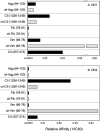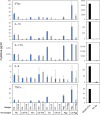The role of posttranslational modifications in generating neo-epitopes that bind to rheumatoid arthritis-associated HLA-DR alleles and promote autoimmune T cell responses
- PMID: 33465118
- PMCID: PMC7815092
- DOI: 10.1371/journal.pone.0245541
The role of posttranslational modifications in generating neo-epitopes that bind to rheumatoid arthritis-associated HLA-DR alleles and promote autoimmune T cell responses
Abstract
While antibodies to citrullinated proteins have become a diagnostic hallmark in rheumatoid arthritis (RA), we still do not understand how the autoimmune T cell response is influenced by these citrullinated proteins. To investigate the role of citrullinated antigens in HLA-DR1- and DR4-restricted T cell responses, we utilized mouse models that express these MHC-II alleles to determine the relationship between citrullinated peptide affinity for these DR molecules and the ability of these peptides to induce a T cell response. Using a set of peptides from proteins thought to be targeted by the autoimmune T cell responses in RA, aggrecan, vimentin, fibrinogen, and type II collagen, we found that while citrullination can enhance the binding affinity for these DR alleles, it does not always do so, even when in the critical P4 position. Moreover, if peptide citrullination does enhance HLA-DR binding affinity, it does not necessarily predict the generation of a T cell response. Conversely, citrullinated peptides can stimulate T cells without changing the peptide binding affinity for HLA-DR1 or DR4. Furthermore, citrullination of an autoantigen, type II collagen, which enhances binding affinity to HLA-DR1 did not enhance the severity of autoimmune arthritis in HLA-DR1 transgenic mice. Additional analysis of clonal T cell populations stimulated by these peptides indicated cross recognition of citrullinated and wild type peptides can occur in some instances, while in others cases the citrullination generates a novel T cell epitope. Finally, cytokine profiles of the wild type and citrullinated peptide stimulated T cells unveiled a significant disconnect between proliferation and cytokine production. Altogether, these data demonstrate the lack of support for a simplified model with universal correlation between affinity for HLA-DR alleles, immunogenicity and arthritogenicity of citrullinated peptides. Additionally they highlight the complexity of both T cell receptor recognition of citrulline as well as its potential conformational effects on the peptide:HLA-DR complex as recognized by a self-reactive cell receptor.
Conflict of interest statement
This work was supported by a Merit Review grant from the Department of Veterans Affairs (E.F.R.), and by funding from Janssen Research and Development (E.F.R.). Janssen Research and Development provided financial support in the form of authors’ salaries (S.B and N.L.R.), study design, data analyses, and preparation of the manuscript. This commercial affiliation does not alter our adherence to all PLOS ONE policies on sharing data and materials.
Figures








References
Publication types
MeSH terms
Substances
Grants and funding
LinkOut - more resources
Full Text Sources
Other Literature Sources
Medical
Molecular Biology Databases
Research Materials

